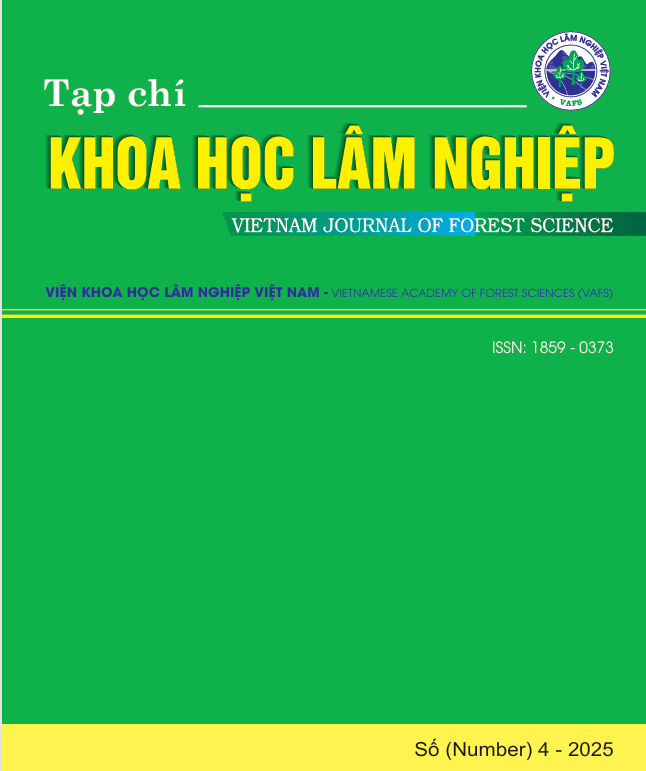BIODIVERSITY IN POOR AND SEVERELY POOR FORESTS IN QUANG NINH PROVINCE
DOI:
https://doi.org/10.70169/VJFS.1062Keywords:
Canopy forest tree species, biodiversity, poor forest, severely poor forest, Quang NinhAbstract
The study was conducted to assess the biodiversity of canopy forest tree species in forest stands of two forest types, poor forest and severely poor forest, in Quang Ninh province. The study was carried out a survey of 24 temporary random sample plots, which were evenly distributed across three main areas as the Eastern, Western, and Central regions of the research site with the use of the latest forest dynamics data in 2024 in this study. With a total area of the forest stands of 60,728.0 hectares (accounting for 50.62% of the total natural forest area), these forest states exhibit specific biodiversity characteristics. The structural complexity of the poor forest is higher than that of the severely poor forest, both when considered overall for each forest state and individually for each area (higher in Complexity Index - CI), but it has a lower species mixture level (lower in Mixture Index - HG). The analysis of three biodiversity indices-Simpson, Shannon - Weiner, and Rényi entropy-reveals that the biodiversity level of canopy tree species in the poor forest is higher than in the severely poor forest. However, these differences were not found to be statistically significant, and species diversity remained comparatively low and localized to specific areas. A total of 26 types of uses were documented for the woody tree species in the study area, with the primary use being timber extraction. In light of these findings, it is necessary to pay more attention to forest conservation and development, particularly through the implementation of appropriate silvicultural techniques to contribute to sustainable forestry development in Quang Ninh.
References
1 BMZ - Bộ Hợp tác và Phát triển Kinh tế Liên bang Đức, 2021. Báo cáo Chương trình bảo tồn, sử dụng bền vững đa dạng sinh học và các dịch vụ hệ sinh thái rừng Việt Nam.
2 Bộ Nông nghiệp và Phát triển nông thôn, 2000. Tên cây rừng Việt Nam, Nhà xuất bản Nông nghiệp, Hà Nội.
3 Ngọc Diệp, 2021. Đa dạng sinh học ở Việt Nam: Thực trạng và các giải pháp. Tạp chí Cộng sản.
4 Holdridge L.R., 1967. Life Zone System. No. (rev. ed.). Tropical Science Center, San Jose, Costa Rica.
5 Nguyễn Văn Hợp, 2017. Một số đặc điểm hệ thực vật thân gỗ kiểu phụ rừng lùn tại Vườn Quốc gia Bidoup - Núi Bà, tỉnh Lâm Đồng. Tạp chí Khoa học và Công nghệ Lâm nghiệp, số 3.
6 Magurran AE, 1988. Ecological diversity and its measurement. Princeton University Press, Princeton.
7 Simpson, E. H., 1949. Measurment of diversity. London: Nature 163: 688.
8 Shanno, C.E. and W. Wiener., 1963. The mathematical theoy of communities. Illinion: Urnbana University, Illinois Press.
9 Nguyễn Toàn Thắng, Trần Văn Đô, Hoàng Thanh Sơn, Trịnh Ngọc Bon, Dương Quang Trung, Vũ Tiến Lâm, Hoàng Văn Thành, Đào Trung Đức và Nguyễn Hữu Hiệp, 2024. Đa dạng sinh học loài cây gỗ tại rừng tự nhiên Huyện Ba Chẽ, Tỉnh Quảng Ninh. Tạp chí Khoa học Lâm nghiệp, số 4.
10 Theodore D. Gress, Noah A. Rosenberg, 2024. Mathematical constraints on a family of biodiversity measures via connections with Rényi entropy. BioSystems, Volume 237.
11 Viện Sinh thái và Tài nguyên sinh vật, 1999. 1900 loài cây có ích ở Việt Nam. Nhà xuất bản Thế giới.









